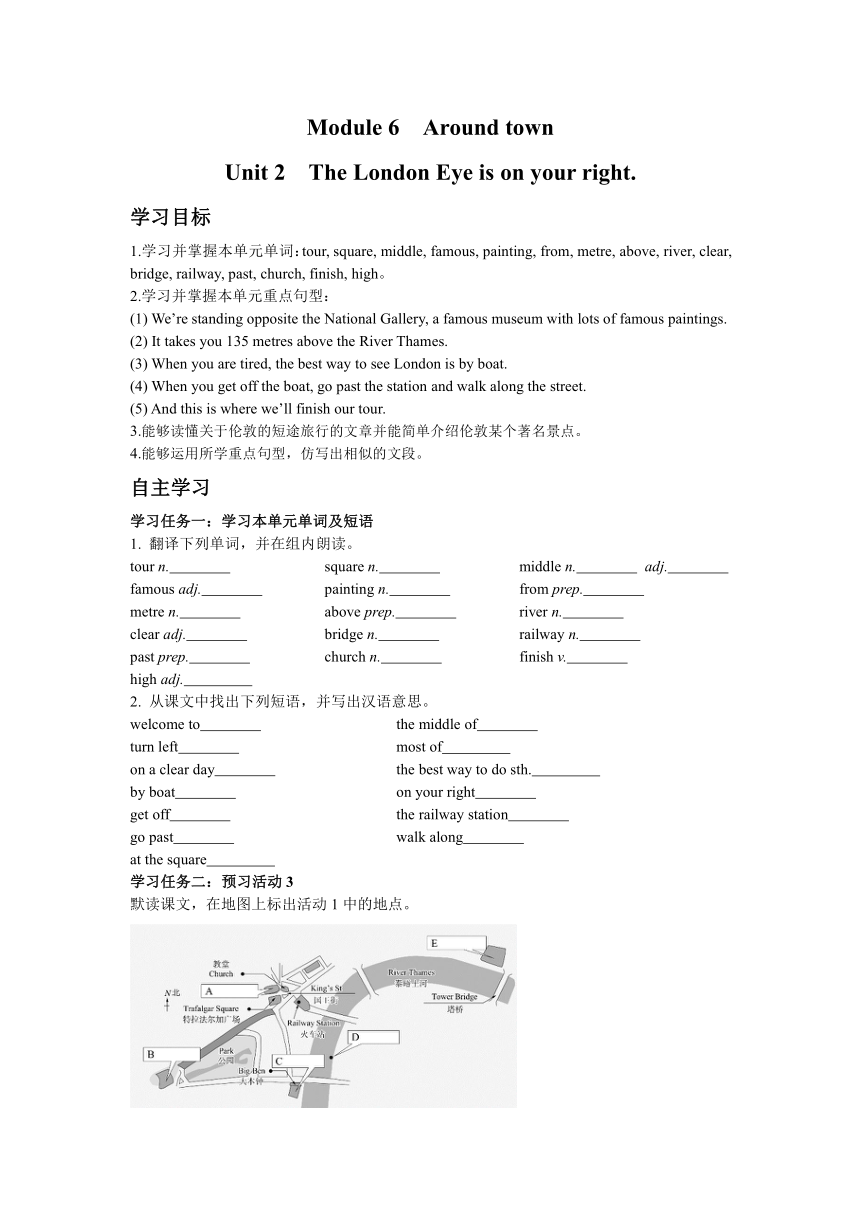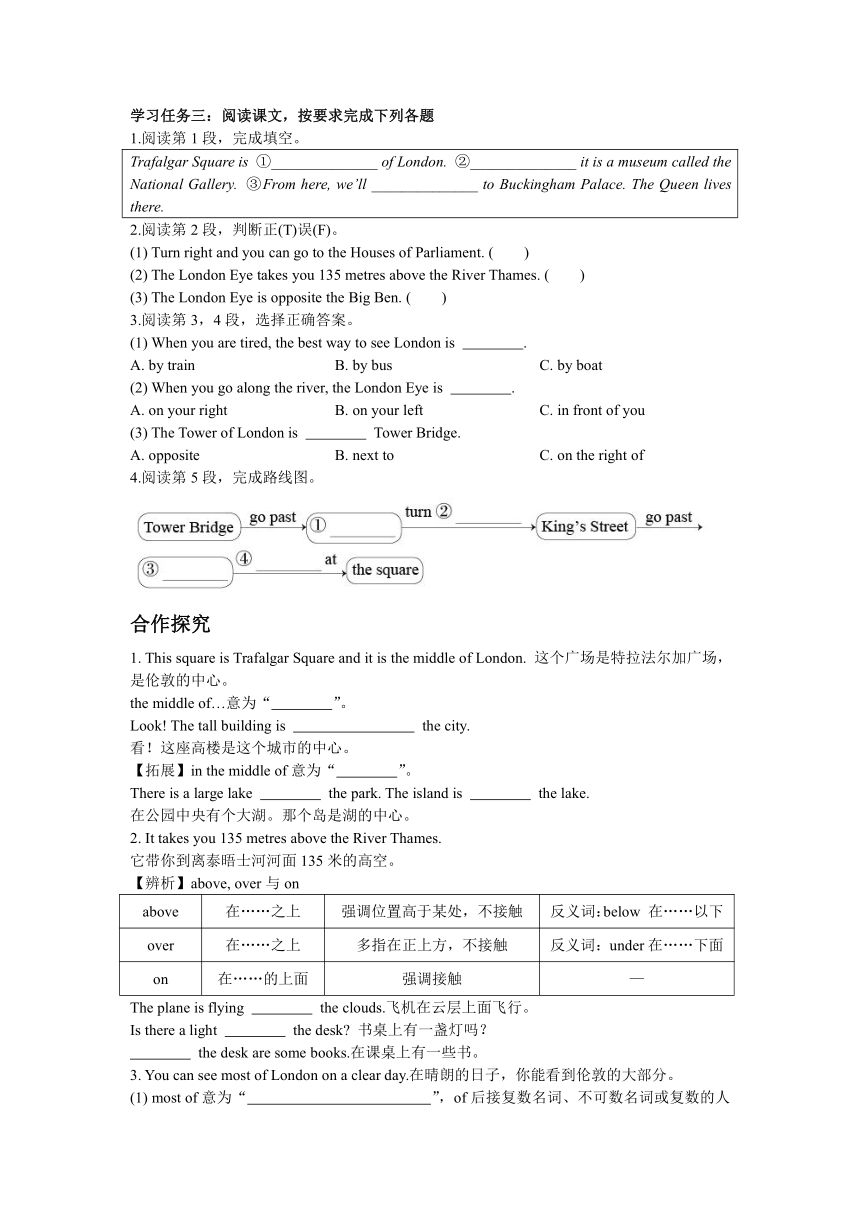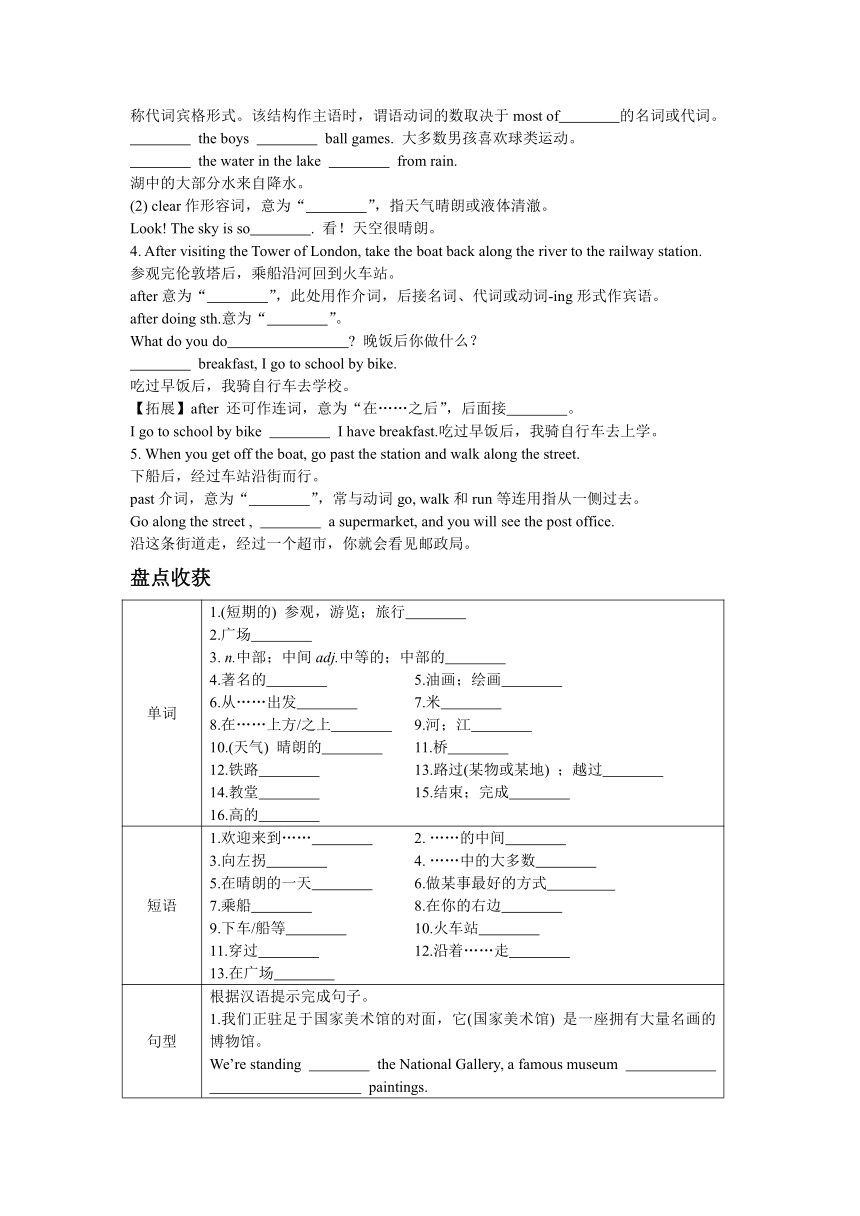Module 6 Unit 2同步学案-外语教研版中学英语七年级下
文档属性
| 名称 | Module 6 Unit 2同步学案-外语教研版中学英语七年级下 |  | |
| 格式 | docx | ||
| 文件大小 | 154.5KB | ||
| 资源类型 | 试卷 | ||
| 版本资源 | 外研版 | ||
| 科目 | 英语 | ||
| 更新时间 | 2024-02-21 19:17:34 | ||
图片预览



文档简介
Module 6 Around town
Unit 2 The London Eye is on your right.
学习目标
1.学习并掌握本单元单词:tour, square, middle, famous, painting, from, metre, above, river, clear, bridge, railway, past, church, finish, high。
2.学习并掌握本单元重点句型:
(1) We’re standing opposite the National Gallery, a famous museum with lots of famous paintings.
(2) It takes you 135 metres above the River Thames.
(3) When you are tired, the best way to see London is by boat.
(4) When you get off the boat, go past the station and walk along the street.
(5) And this is where we’ll finish our tour.
3.能够读懂关于伦敦的短途旅行的文章并能简单介绍伦敦某个著名景点。
4.能够运用所学重点句型,仿写出相似的文段。
自主学习
学习任务一:学习本单元单词及短语
1. 翻译下列单词,并在组内朗读。
tour n. square n. middle n. adj.
famous adj. painting n. from prep.
metre n. above prep. river n.
clear adj. bridge n. railway n.
past prep. church n. finish v.
high adj.
2. 从课文中找出下列短语,并写出汉语意思。
welcome to the middle of
turn left most of
on a clear day the best way to do sth.
by boat on your right
get off the railway station
go past walk along
at the square
学习任务二:预习活动3
默读课文,在地图上标出活动1中的地点。
学习任务三:阅读课文,按要求完成下列各题
1.阅读第1段,完成填空。
Trafalgar Square is ①______________ of London. ②______________ it is a museum called the National Gallery. ③From here, we’ll ______________ to Buckingham Palace. The Queen lives there.
2.阅读第2段,判断正(T)误(F)。
(1) Turn right and you can go to the Houses of Parliament. ( )
(2) The London Eye takes you 135 metres above the River Thames. ( )
(3) The London Eye is opposite the Big Ben. ( )
3.阅读第3,4段,选择正确答案。
(1) When you are tired, the best way to see London is .
A. by train B. by bus C. by boat
(2) When you go along the river, the London Eye is .
A. on your right B. on your left C. in front of you
(3) The Tower of London is Tower Bridge.
A. opposite B. next to C. on the right of
4.阅读第5段,完成路线图。
合作探究
1. This square is Trafalgar Square and it is the middle of London. 这个广场是特拉法尔加广场,是伦敦的中心。
the middle of…意为“ ”。
Look! The tall building is the city.
看!这座高楼是这个城市的中心。
【拓展】in the middle of意为“ ”。
There is a large lake the park. The island is the lake.
在公园中央有个大湖。那个岛是湖的中心。
2. It takes you 135 metres above the River Thames.
它带你到离泰晤士河河面135米的高空。
【辨析】above, over与on
above 在……之上 强调位置高于某处,不接触 反义词:below 在……以下
over 在……之上 多指在正上方,不接触 反义词:under在……下面
on 在……的上面 强调接触 —
The plane is flying the clouds.飞机在云层上面飞行。
Is there a light the desk 书桌上有一盏灯吗?
the desk are some books.在课桌上有一些书。
3. You can see most of London on a clear day.在晴朗的日子,你能看到伦敦的大部分。
(1) most of意为“ ”,of后接复数名词、不可数名词或复数的人称代词宾格形式。该结构作主语时,谓语动词的数取决于most of 的名词或代词。
the boys ball games. 大多数男孩喜欢球类运动。
the water in the lake from rain.
湖中的大部分水来自降水。
(2) clear作形容词,意为“ ”,指天气晴朗或液体清澈。
Look! The sky is so . 看!天空很晴朗。
4. After visiting the Tower of London, take the boat back along the river to the railway station.
参观完伦敦塔后,乘船沿河回到火车站。
after意为“ ”,此处用作介词,后接名词、代词或动词-ing形式作宾语。
after doing sth.意为“ ”。
What do you do 晚饭后你做什么?
breakfast, I go to school by bike.
吃过早饭后,我骑自行车去学校。
【拓展】after 还可作连词,意为“在……之后”,后面接 。
I go to school by bike I have breakfast.吃过早饭后,我骑自行车去上学。
5. When you get off the boat, go past the station and walk along the street.
下船后,经过车站沿街而行。
past介词,意为“ ”,常与动词go, walk和run等连用指从一侧过去。
Go along the street , a supermarket, and you will see the post office.
沿这条街道走,经过一个超市,你就会看见邮政局。
盘点收获
单词 1.(短期的) 参观,游览;旅行 2.广场 3. n.中部;中间adj.中等的;中部的 4.著名的 5.油画;绘画 6.从……出发 7.米 8.在……上方/之上 9.河;江 10.(天气) 晴朗的 11.桥 12.铁路 13.路过(某物或某地) ;越过 14.教堂 15.结束;完成 16.高的
短语 1.欢迎来到…… 2. ……的中间 3.向左拐 4. ……中的大多数 5.在晴朗的一天 6.做某事最好的方式 7.乘船 8.在你的右边 9.下车/船等 10.火车站 11.穿过 12.沿着……走 13.在广场
句型 根据汉语提示完成句子。 1.我们正驻足于国家美术馆的对面,它(国家美术馆) 是一座拥有大量名画的博物馆。 We’re standing the National Gallery, a famous museum paintings.
续表
句型 2.它可以将你带到距离泰晤士河面135米的高空。 135 metres above the River Thames. 3.当你顺流而下,伦敦眼就在你的右边。 you go along the river, the London Eye is . 4.下船后,经过车站沿街而行。 When you the boat, go the station and walk the street. 5.这也是我们将结束旅行的地方。 And this is finish our tour.
语法 方位介词的用法
写作 简单介绍伦敦某个著名景点
当堂达标
Ⅰ.单项填空。
1. When I walk the classroom, I see Tony doing his homework.
A. along B. past C. across D. with
2. First, you should finish your composition.
A. write B. writing C. make D. making
3. This bus doesn’t go to the railway station. I’m afraid you’ll have to at Bluesky Stop and take BRT Line 1.
A. take off B. put off C. get off D. get out
4. It is going to rain. Take an umbrella you.
A. with B. at C. in D. from
5. Our office is the shop and we often go downstairs to buy things.
A. above B. in C. between D. at
Ⅱ.根据句意及首字母或汉语提示完成句子。
1.—What a c day it is today!
—Yes. Look at the big sun.
2. How many (教堂) are there in your city
3. There is an old b over the river.
4. The (油画) on the wall are very beautiful.
5. The Great Wall is very (著名的) in the world.
6. The railway station is about 1,000 m from my home.
Ⅲ.根据汉语意思完成句子(每空一词) 。
1.参观完火车站后,我们将去参观城市广场。
After the railway station, we the city square.
2.从这儿,你能看到这个城市的大部分。
From here, you can see the city.
3.伦敦眼在你的右边。
The London Eye is .
4.阅读是学习英语最好的方法。
Reading is English.
5.我们打算在下一站下车。
We are going to at the next stop.
Ⅳ.完形填空。
Hello, everyone. Welcome 1 Beijing Zoo. Here is our tour plan. 2 carefully. First we 3 the Children’s Zoo. After that, we walk 4 the Bird World. Next is the African Area. 5 are elephants and lions. Don’t 6 afraid:the cages are safe.
Then, we have 7 lunch. Everybody brings their lunch, right Some of you don’t have drinks. There are many places 8 drinks.
After lunch, we go to the Asian Area. Last, there is the Butterfly Park. It’s 9 the Snake Park. Then we come back here and get on the bus. Remember, don’t feed the animals. OK, let’s
10 !
1. A. to B. in C. from D. at
2. A. Listen B. Listen to C. Hear D. Hear of
3. A. see B. look C. visit D. watch
4. A. in front B. across C. over D. between
5. A. They B. It C. There D. Where
6. A. am B. is C. are D. be
7. A. a B. an C. the D. /
8. A. buy B. buys C. to buy D. buying
9. A. to B. opposite C. on D. for
10. A. have fun B. to have a nice day
C. having a good time D. having fun
学后反思
当堂达标参考答案:
Ⅰ. 1. B walk past意为“走过”,past介词,意为“路过”。
2. B finish意为“完成”,后接v.-ing形式作宾语。
3. C 结合语境可知,此处表示“下车”,应用get off。
4. A 根据“Take an umbrella…”可知此处表示伴随,用介词with。
5. A 由题干后半句话中的downstairs可推断出,our office是在shop的上面。
Ⅱ. 1. clear 2. churches 3. bridge 4. paintings 5. famous 6. metres
Ⅲ. 1. visiting; will visit 2. most of 3. on your right 4. the best way to learn 5. get off
Ⅳ. 1. A 表示“欢迎来到……”用welcome to...,后跟表示地点的名词。
2. A 本题可用“排除法”解答。动词listen强调的是“听”的动作,而hear强调的是“听”的结果,hear of意为“听说”。句意为“认真地听”,表达的是动作,故排除选项C、D两项;而动词listen用作不及物动词,短语listen to后需跟宾语。所以选项A是正确的。
3. C 根据句中的宾语可推知,句中表达的意思为“参观”,表示“参观”用动词visit。
4. B 句中表示的是“走着穿过”,用短语walk across。所以选项B是正确的。
5. C 表示“(某地)有某物”用there be句型,句中表达的是“(在非洲区)有大象和狮子”。所以选项C是正确的。
6. D 表示“害怕”用be afraid,don’t的后面要跟动词原形。所以选项D是正确的。
7. D 表示“吃早/午/晚饭”用have breakfast/lunch/dinner,三餐前不加任何冠词。
8. C 结合上句“你们中有些人没有带饮料”可知,本句意为“有很多地方可以买饮料”。由句意可知此处用动词不定式作定语修饰前面的places,故选C。
9. B 句中表达的是地点与地点之间的位置关系,结合逻辑可知选B。
10. A 动词let用作使役动词,后面跟动词原形作宾补,所以选项A是正确的。
Unit 2 The London Eye is on your right.
学习目标
1.学习并掌握本单元单词:tour, square, middle, famous, painting, from, metre, above, river, clear, bridge, railway, past, church, finish, high。
2.学习并掌握本单元重点句型:
(1) We’re standing opposite the National Gallery, a famous museum with lots of famous paintings.
(2) It takes you 135 metres above the River Thames.
(3) When you are tired, the best way to see London is by boat.
(4) When you get off the boat, go past the station and walk along the street.
(5) And this is where we’ll finish our tour.
3.能够读懂关于伦敦的短途旅行的文章并能简单介绍伦敦某个著名景点。
4.能够运用所学重点句型,仿写出相似的文段。
自主学习
学习任务一:学习本单元单词及短语
1. 翻译下列单词,并在组内朗读。
tour n. square n. middle n. adj.
famous adj. painting n. from prep.
metre n. above prep. river n.
clear adj. bridge n. railway n.
past prep. church n. finish v.
high adj.
2. 从课文中找出下列短语,并写出汉语意思。
welcome to the middle of
turn left most of
on a clear day the best way to do sth.
by boat on your right
get off the railway station
go past walk along
at the square
学习任务二:预习活动3
默读课文,在地图上标出活动1中的地点。
学习任务三:阅读课文,按要求完成下列各题
1.阅读第1段,完成填空。
Trafalgar Square is ①______________ of London. ②______________ it is a museum called the National Gallery. ③From here, we’ll ______________ to Buckingham Palace. The Queen lives there.
2.阅读第2段,判断正(T)误(F)。
(1) Turn right and you can go to the Houses of Parliament. ( )
(2) The London Eye takes you 135 metres above the River Thames. ( )
(3) The London Eye is opposite the Big Ben. ( )
3.阅读第3,4段,选择正确答案。
(1) When you are tired, the best way to see London is .
A. by train B. by bus C. by boat
(2) When you go along the river, the London Eye is .
A. on your right B. on your left C. in front of you
(3) The Tower of London is Tower Bridge.
A. opposite B. next to C. on the right of
4.阅读第5段,完成路线图。
合作探究
1. This square is Trafalgar Square and it is the middle of London. 这个广场是特拉法尔加广场,是伦敦的中心。
the middle of…意为“ ”。
Look! The tall building is the city.
看!这座高楼是这个城市的中心。
【拓展】in the middle of意为“ ”。
There is a large lake the park. The island is the lake.
在公园中央有个大湖。那个岛是湖的中心。
2. It takes you 135 metres above the River Thames.
它带你到离泰晤士河河面135米的高空。
【辨析】above, over与on
above 在……之上 强调位置高于某处,不接触 反义词:below 在……以下
over 在……之上 多指在正上方,不接触 反义词:under在……下面
on 在……的上面 强调接触 —
The plane is flying the clouds.飞机在云层上面飞行。
Is there a light the desk 书桌上有一盏灯吗?
the desk are some books.在课桌上有一些书。
3. You can see most of London on a clear day.在晴朗的日子,你能看到伦敦的大部分。
(1) most of意为“ ”,of后接复数名词、不可数名词或复数的人称代词宾格形式。该结构作主语时,谓语动词的数取决于most of 的名词或代词。
the boys ball games. 大多数男孩喜欢球类运动。
the water in the lake from rain.
湖中的大部分水来自降水。
(2) clear作形容词,意为“ ”,指天气晴朗或液体清澈。
Look! The sky is so . 看!天空很晴朗。
4. After visiting the Tower of London, take the boat back along the river to the railway station.
参观完伦敦塔后,乘船沿河回到火车站。
after意为“ ”,此处用作介词,后接名词、代词或动词-ing形式作宾语。
after doing sth.意为“ ”。
What do you do 晚饭后你做什么?
breakfast, I go to school by bike.
吃过早饭后,我骑自行车去学校。
【拓展】after 还可作连词,意为“在……之后”,后面接 。
I go to school by bike I have breakfast.吃过早饭后,我骑自行车去上学。
5. When you get off the boat, go past the station and walk along the street.
下船后,经过车站沿街而行。
past介词,意为“ ”,常与动词go, walk和run等连用指从一侧过去。
Go along the street , a supermarket, and you will see the post office.
沿这条街道走,经过一个超市,你就会看见邮政局。
盘点收获
单词 1.(短期的) 参观,游览;旅行 2.广场 3. n.中部;中间adj.中等的;中部的 4.著名的 5.油画;绘画 6.从……出发 7.米 8.在……上方/之上 9.河;江 10.(天气) 晴朗的 11.桥 12.铁路 13.路过(某物或某地) ;越过 14.教堂 15.结束;完成 16.高的
短语 1.欢迎来到…… 2. ……的中间 3.向左拐 4. ……中的大多数 5.在晴朗的一天 6.做某事最好的方式 7.乘船 8.在你的右边 9.下车/船等 10.火车站 11.穿过 12.沿着……走 13.在广场
句型 根据汉语提示完成句子。 1.我们正驻足于国家美术馆的对面,它(国家美术馆) 是一座拥有大量名画的博物馆。 We’re standing the National Gallery, a famous museum paintings.
续表
句型 2.它可以将你带到距离泰晤士河面135米的高空。 135 metres above the River Thames. 3.当你顺流而下,伦敦眼就在你的右边。 you go along the river, the London Eye is . 4.下船后,经过车站沿街而行。 When you the boat, go the station and walk the street. 5.这也是我们将结束旅行的地方。 And this is finish our tour.
语法 方位介词的用法
写作 简单介绍伦敦某个著名景点
当堂达标
Ⅰ.单项填空。
1. When I walk the classroom, I see Tony doing his homework.
A. along B. past C. across D. with
2. First, you should finish your composition.
A. write B. writing C. make D. making
3. This bus doesn’t go to the railway station. I’m afraid you’ll have to at Bluesky Stop and take BRT Line 1.
A. take off B. put off C. get off D. get out
4. It is going to rain. Take an umbrella you.
A. with B. at C. in D. from
5. Our office is the shop and we often go downstairs to buy things.
A. above B. in C. between D. at
Ⅱ.根据句意及首字母或汉语提示完成句子。
1.—What a c day it is today!
—Yes. Look at the big sun.
2. How many (教堂) are there in your city
3. There is an old b over the river.
4. The (油画) on the wall are very beautiful.
5. The Great Wall is very (著名的) in the world.
6. The railway station is about 1,000 m from my home.
Ⅲ.根据汉语意思完成句子(每空一词) 。
1.参观完火车站后,我们将去参观城市广场。
After the railway station, we the city square.
2.从这儿,你能看到这个城市的大部分。
From here, you can see the city.
3.伦敦眼在你的右边。
The London Eye is .
4.阅读是学习英语最好的方法。
Reading is English.
5.我们打算在下一站下车。
We are going to at the next stop.
Ⅳ.完形填空。
Hello, everyone. Welcome 1 Beijing Zoo. Here is our tour plan. 2 carefully. First we 3 the Children’s Zoo. After that, we walk 4 the Bird World. Next is the African Area. 5 are elephants and lions. Don’t 6 afraid:the cages are safe.
Then, we have 7 lunch. Everybody brings their lunch, right Some of you don’t have drinks. There are many places 8 drinks.
After lunch, we go to the Asian Area. Last, there is the Butterfly Park. It’s 9 the Snake Park. Then we come back here and get on the bus. Remember, don’t feed the animals. OK, let’s
10 !
1. A. to B. in C. from D. at
2. A. Listen B. Listen to C. Hear D. Hear of
3. A. see B. look C. visit D. watch
4. A. in front B. across C. over D. between
5. A. They B. It C. There D. Where
6. A. am B. is C. are D. be
7. A. a B. an C. the D. /
8. A. buy B. buys C. to buy D. buying
9. A. to B. opposite C. on D. for
10. A. have fun B. to have a nice day
C. having a good time D. having fun
学后反思
当堂达标参考答案:
Ⅰ. 1. B walk past意为“走过”,past介词,意为“路过”。
2. B finish意为“完成”,后接v.-ing形式作宾语。
3. C 结合语境可知,此处表示“下车”,应用get off。
4. A 根据“Take an umbrella…”可知此处表示伴随,用介词with。
5. A 由题干后半句话中的downstairs可推断出,our office是在shop的上面。
Ⅱ. 1. clear 2. churches 3. bridge 4. paintings 5. famous 6. metres
Ⅲ. 1. visiting; will visit 2. most of 3. on your right 4. the best way to learn 5. get off
Ⅳ. 1. A 表示“欢迎来到……”用welcome to...,后跟表示地点的名词。
2. A 本题可用“排除法”解答。动词listen强调的是“听”的动作,而hear强调的是“听”的结果,hear of意为“听说”。句意为“认真地听”,表达的是动作,故排除选项C、D两项;而动词listen用作不及物动词,短语listen to后需跟宾语。所以选项A是正确的。
3. C 根据句中的宾语可推知,句中表达的意思为“参观”,表示“参观”用动词visit。
4. B 句中表示的是“走着穿过”,用短语walk across。所以选项B是正确的。
5. C 表示“(某地)有某物”用there be句型,句中表达的是“(在非洲区)有大象和狮子”。所以选项C是正确的。
6. D 表示“害怕”用be afraid,don’t的后面要跟动词原形。所以选项D是正确的。
7. D 表示“吃早/午/晚饭”用have breakfast/lunch/dinner,三餐前不加任何冠词。
8. C 结合上句“你们中有些人没有带饮料”可知,本句意为“有很多地方可以买饮料”。由句意可知此处用动词不定式作定语修饰前面的places,故选C。
9. B 句中表达的是地点与地点之间的位置关系,结合逻辑可知选B。
10. A 动词let用作使役动词,后面跟动词原形作宾补,所以选项A是正确的。
同课章节目录
- Module 1 Lost and found
- Unit 1 Whose bag is this?
- Unit 2 Are they yours?
- Unit 3 Language in use
- Module 2 What can you do ?
- Unit 1 I can play the piano
- Unit 2 I can run really fast
- Unit 3 Language in use
- Module 3 Making plans
- Unit 1 What are you going to do at the weekends?
- Unit 2 We're going to cheer the players.
- Unit 3 Language in use
- Module 4 Life in the future
- Unit 1 Everyone will study at home
- Unit 2 Every family will have a small plane.
- Unit 3 Language in use
- Module 5 Shopping
- Unit 1 What can I do for you?
- Unit 2 You can buy everything on the Internet
- Unit 3 Language in use
- Module 6 Around town
- Unit 1 Could you tell me how to get to the Nationa
- Unit 2 The London Eye is on your right.
- Unit 3 Language in use
- Revision module A
- Module 7 My past life
- Unit 1 I was born in a small village.
- Unit 2 I was born in Quincy.
- Unit 3 Language in use
- Module 8 Story time
- Unit 1 Once upon a time….
- Unit 2 Goldilocks hurried out of the house.
- Unit 3 Language in use
- Module 9 Life history
- Unit 1 He left school and began work at the age of
- Unit 2 He decided to be an actor.
- Unit 3 Language in use
- Module 10 A holiday journey
- Unit 1 What did you do?
- Unit 2 This morning we took a walk.
- Unit 3 Language in use
- Module 11 Body language
- Unit 1 They touch noses!
- Unit 2 Here are some ways to welcome them.
- Unit 3 Language in use
- Module 12 Western music
- Unit 1 It's so beautiful!
- Unit 2 Vienna is the centre of European classical
- Unit 3 Language in use
- Revision module B
